

Iris is both beautiful and elegant, and luckily it is also easy to grow given the simply stunning blooming it offers.
Summary of key Iris facts
Name: Iris
Family: Iridaceae
Type: bulbous flower or perennial
Height: 8 to 36 inches (20 to 90 cm)
Exposure: full sun, part sun
Soil: ordinary – Flowering: January to July depending on the variety
Here is the care and small acts of care that will sustain the beautiful blooming of your iris from year to year.
The best period for planting iris is spring or summer, usually from May to November for the plants to bloom in the following summer.
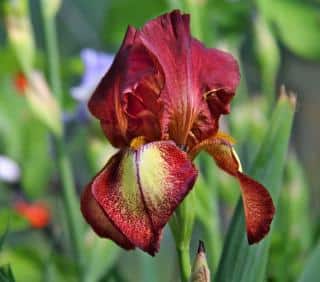 Plant the iris rhizomes in soil that has been well broken up, without burying them too deep.
Plant the iris rhizomes in soil that has been well broken up, without burying them too deep.Iris is especially vulnerable to lack of sun that would keep it from blooming correctly, and its second nemesis is waterlogged soil.
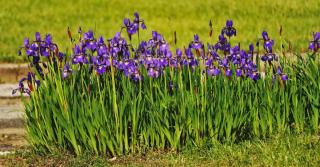 If sowing from seed, better sow your iris in pots in September-October.
If sowing from seed, better sow your iris in pots in September-October.
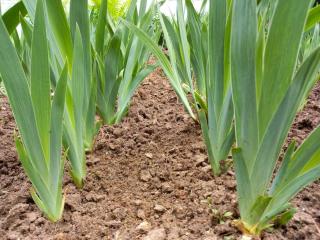 Iris is a plant that very easily propagates through division.
Iris is a plant that very easily propagates through division.
As years go by, rhizomes tend to crowd tighter and tighter, the soil loses its nutrients and the iris blooms are weaker and weaker.
That is the right time to divide your iris so that the rhizomes get to breathe a bit and their vigor is renewed.
The technique to propagate iris is actually rhizome division after the blooming every 3 to 4 years.
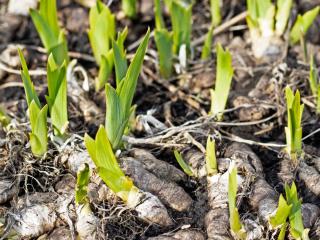 With a spading fork, carefully unearth a portion of the rhizomes, lifting them out of the ground.
With a spading fork, carefully unearth a portion of the rhizomes, lifting them out of the ground.This step gives the plant a new life, and it will joyfully get to work making new flowers for you for free!
Caring for iris can really become only the occasional check, because this is a flower that requires very little work.
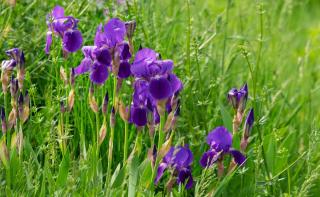 Apart from dividing the rhizomes as described above, here are the practices that will help extend the blooming or simply increase the quality of the iris flowers.
Apart from dividing the rhizomes as described above, here are the practices that will help extend the blooming or simply increase the quality of the iris flowers.
Iris resists dry spells particularly well and will only need to be watered in case of very high temperatures and/or extended dry spell.
However, potted iris will need much more regular watering, usually when the substrate has dried up deep down.
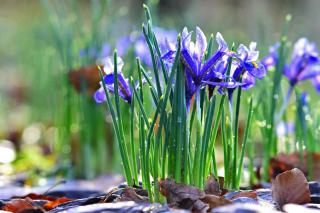 Iris is quite invulnerable to disease but it may fall victim to snails and slugs.
Iris is quite invulnerable to disease but it may fall victim to snails and slugs.
Iris is a hardy plant that survives winter without batting an eye. Cold actually conditions part of the plant’s growth.
Three magnificent petals form the flower, and their colors are most varied.
Often in tones of purple, they can also be blue, yellow, red or white.
The lifespan of an iris can reach anywhere from 5 to 20 years and its hardiness and resistance to the cold can reach down to 5°F (-15°C).
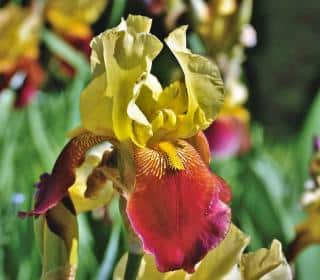 Over 200 species of iris have been accounted for, and each has a unique color and shape combination. Some love basking in water, like yellow iris. Others are all the rage, like the many ravishing bearded iris varieties. A few pictured here are actually dwarf iris, excellent for growing in pots. Particularly elegant is the slender-stemmed Dutch iris.
Over 200 species of iris have been accounted for, and each has a unique color and shape combination. Some love basking in water, like yellow iris. Others are all the rage, like the many ravishing bearded iris varieties. A few pictured here are actually dwarf iris, excellent for growing in pots. Particularly elegant is the slender-stemmed Dutch iris.
Note that certain iris species are used to produce perfume, with oils extracted from the rhizome.
To ensure it lasts a generation, offer it bulb-plant organic fertilizer every year after the blooming.